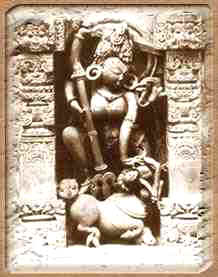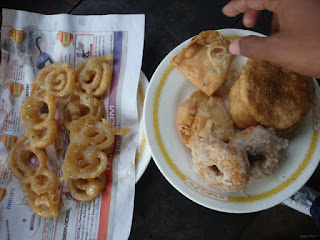Buddha Purnima also known as Buddha
Jayanti is the most sacred Buddhist festival. A holy festival, Buddha
Purnima is celebrated to commemorate the birthday of Lord Buddha, the
founder of Buddhism. Buddha Purnima is celebrated in the month of Vaisakh
(on the full moon of the fourth lunar month ), which usually falls in the
months of April or May.
The festival day marks three important events related to Buddha's life namely (i) his birth in the year 623 B.C (ii) his enlightenment in 588 B.C and (iii) his attainment of Nirvana, that is the complete extinction of his self at the age of 80. Hence, the Buddhists around the world consider the Buddha Purnima day to be more auspicious than any other day of the year. Though, not all Buddhists commemorate these three events on this very day, but the events are remembered by all of them.
Buddha Purnima is especially celebrated in Bodh Gaya, Lumbini and Kushinara. During Buddha Purnima , believers come to Bodh Gaya from all over the world to attend the celebrations. Sarnath considered the capital of Buddhish, celebrates the festival day in a grand way. Likewise in India, Buddha Purnima is also celebrated in Sri Lanka, where it is known as Vishakha Pujain. Other notable countries where Buddha Purnima is celebrated include Burma (Myanmar), Bhutan, Cambodia, China, Nepal, Thailand, Tibet, Korea, Laos, Vietnam, Mongolia and Japan.
History of Buddha Purnima
According to holy scriptures, Lord Buddha is considered as the ninth avatar (incarnation) of Lord Vishnu (Preserver in the Hindu Holy Trinity of Creator-Preserver-Destroyer). Literally Buddha means 'enlighted one', someone who is totally free from all faults and mental obstructions.
Legend has it that Lord Buddha's wife Yashodhara, his first disciple Ananda, his charioteer Channa and his horse Kantaka were all born on Buddha Purnima day. It is also believed that even the Bodhi tree, under which Buddha attained nirvana has been created on this day. Besides, on this day Lord Buddha opted to preach his first sermon at Varanasi.
Buddha Purnima Celebrations
Buddha Purnima day is marked by massive prayed meets, sermons on the life of Lord Buddha, regular recitation of Buddhist holy scriptures, religious discourses, group meditation, processions, worship of the Buddha statue and symposia. During Buddha Purnima the Mahabodhi temple at Bodh Gaya adorn into a festive look and is beautifully decorated with colourful flags and flowers.
Though the Buddha Purnima festival is an occasion for celebration, but it doesn't encourage hectic gaiety. In fact, Buddhists believe to celebrate the festival in tranquil, peaceful mood. Buddhists in India and other Buddhist countries illuminate their houses, temples and streets with colour lanterns, electric light and tastefully decorate their houses.
The festival day marks three important events related to Buddha's life namely (i) his birth in the year 623 B.C (ii) his enlightenment in 588 B.C and (iii) his attainment of Nirvana, that is the complete extinction of his self at the age of 80. Hence, the Buddhists around the world consider the Buddha Purnima day to be more auspicious than any other day of the year. Though, not all Buddhists commemorate these three events on this very day, but the events are remembered by all of them.
Buddha Purnima is especially celebrated in Bodh Gaya, Lumbini and Kushinara. During Buddha Purnima , believers come to Bodh Gaya from all over the world to attend the celebrations. Sarnath considered the capital of Buddhish, celebrates the festival day in a grand way. Likewise in India, Buddha Purnima is also celebrated in Sri Lanka, where it is known as Vishakha Pujain. Other notable countries where Buddha Purnima is celebrated include Burma (Myanmar), Bhutan, Cambodia, China, Nepal, Thailand, Tibet, Korea, Laos, Vietnam, Mongolia and Japan.
History of Buddha Purnima
According to holy scriptures, Lord Buddha is considered as the ninth avatar (incarnation) of Lord Vishnu (Preserver in the Hindu Holy Trinity of Creator-Preserver-Destroyer). Literally Buddha means 'enlighted one', someone who is totally free from all faults and mental obstructions.
Legend has it that Lord Buddha's wife Yashodhara, his first disciple Ananda, his charioteer Channa and his horse Kantaka were all born on Buddha Purnima day. It is also believed that even the Bodhi tree, under which Buddha attained nirvana has been created on this day. Besides, on this day Lord Buddha opted to preach his first sermon at Varanasi.
Buddha Purnima Celebrations
Buddha Purnima day is marked by massive prayed meets, sermons on the life of Lord Buddha, regular recitation of Buddhist holy scriptures, religious discourses, group meditation, processions, worship of the Buddha statue and symposia. During Buddha Purnima the Mahabodhi temple at Bodh Gaya adorn into a festive look and is beautifully decorated with colourful flags and flowers.
Though the Buddha Purnima festival is an occasion for celebration, but it doesn't encourage hectic gaiety. In fact, Buddhists believe to celebrate the festival in tranquil, peaceful mood. Buddhists in India and other Buddhist countries illuminate their houses, temples and streets with colour lanterns, electric light and tastefully decorate their houses.


















































